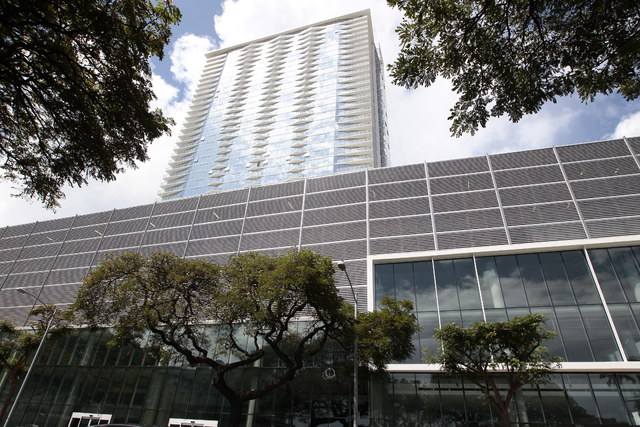A future wave of new homes in Kakaako could be subject to dramatically different affordable-housing rules based on a report presented Wednesday to the state agency governing development in the area.
A four-member committee of the Hawaii Community Development Authority produced the report that recommends major changes to HCDA rules on affordable-housing production.
Some of the proposed changes, including lowering maximum home prices linked to buyer incomes, mirror what a committee of previous board members suggested in 2014.
Other proposed changes are new, such as allowing HCDA to buy back an affordable unit at less than market price regardless of how long the original buyer has owned the home.
Another new recommended change would give developers incentive to produce bigger units at below-market prices instead of focusing, as they often do, on studios and small one-bedroom units with less appeal to families.
“Essentially we’re trying to expand (affordable) housing in Kakaako and preserve what’s already here,” said Steve Scott, who served on the committee with fellow board members William Oh, Wei Fang and Jason Okuhama.
The committee considered the 2014 recommendations and also met with developers, the federal Department of Housing and Urban Development and others.
HCDA has two types of affordable housing under its rules intended for amendment.
“Reserved housing” refers to units that developers must produce when building projects, typically condo towers, that exceed standard height limits in Kakaako on lots bigger than 20,000 square feet. Reserved housing must represent 20 percent of such projects.
“Workforce housing” allows developers to double the density of a project if at least 75 percent of the units meet affordable price limits for buyers.
Under present rules, both types must be affordable to households earning from 100 to 140 percent of Honolulu’s annual median income, which HCDA pegs at $61,550 for a single person or $87,900 for a family of four at the median income, and $86,150 for a single person or $123,050 for a family of four at the 140 percent level.
These limits should be reduced, the committee said, to range between 80 and 120 percent of the median income. That equates to $56,350 for a single person to $80,450 for a family of four at the 80 percent level, and from $73,850 to $105,500 for the same family sizes at 120 percent.
The 2014 committee made the same suggestion. Another prior suggestion mirrored in the new report is to require that below-market rentals produced as reserved housing maintain affordable rents for 30 years instead of 15 years.
Income limits for households in affordable rentals also would be reduced from 100 percent of Honolulu’s median income to 80 percent, under the new recommendations.
Other recommendations in the report include eliminating some restrictions on who can buy affordable housing in Kakaako. Presently, a buyer cannot have more than a certain amount of assets. The asset limit should be changed to exclude retirement savings accounts and allow buyers to receive cash gifts for use as a down payment, the committee said.
Another new recommendation would prohibit developers of workforce housing from sidestepping a bunch of HCDA rules pertaining to parking structure heights, building setbacks, open-space requirements and other things while still allowing twice as much density as a bonus for producing below-market homes. Presently, developers of workforce housing can ask the board to consider a host of rule exemptions. One such project, 801 South Street, was granted several exemptions to the dismay of many nearby residents.
For reserved housing, the committee recommended that any residential project with 10 or more units trigger the requirement to make 20 percent of the units available at below-market prices.
A few details of the committee’s recommendations still need to be filled in by HCDA staff before formal draft language for rule changes is presented to the board, perhaps in August.
Adopting rule changes will be subject to public hearings and a vote by HCDA’s nine-member board.
Some of the proposed changes could be further tweaked through the public hearings and board review process. One issue that arose Wednesday is whether giving HCDA an unending right to repurchase reserved housing or workforce housing units from an original buyer at below-market prices will discourage sales of affordable units and prevent new homeowners from building up significant equity that they can use to buy a bigger home.
This issue was raised by board member Scott Kami, an official with the state Department of Budget and Finance. Kami suggested that first-time buyers should be able to capitalize on home equity at some point, but not after a year or two.
HCDA’s present buyback provision, which allows the agency to resell units at below-market prices to other residents meeting income requirements, applies only to reserved housing units sold by the original buyer within five years. There is no buyback provision for workforce housing units.
If the changes are adopted, the new rules would apply to new development projects not previously permitted or covered by master plans. Developers Howard Hughes Corp. and Kamehameha Schools have 29 planned towers, including five under construction, that are covered by master plans that expire in 2024.

